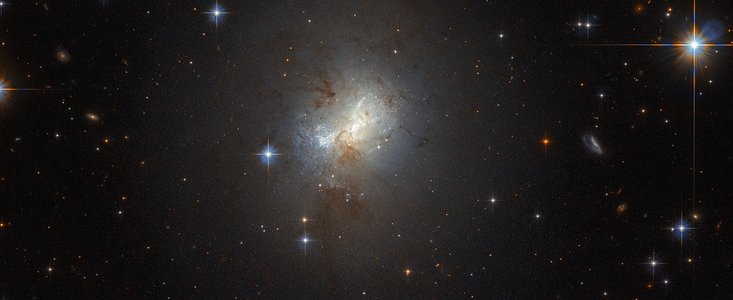Jun 14 2019
ESO 495-21, a tiny galaxy with a big heart, lies embedded within the field of bright foreground stars. Although it may be measuring only 3000 light-years across, this fact is not stopping the galaxy from fiercely forming an enormous number of stars.
 A tiny galaxy with a big heart. (Image credit: NASA, ESA, W. Vacca)
A tiny galaxy with a big heart. (Image credit: NASA, ESA, W. Vacca)
It could also be home to a supermassive black hole; this is strange for a galaxy of its size and might offer interesting clues related to the formation and evolution of galaxies.
ESO 495-21 is located nearly 30 million light-years away in the constellation of Pyxis (The Compass) and is a dwarf starburst galaxy—suggesting that it is small in size, but burning with fast bursts of star formation. In starburst galaxies, star formation occurs at extremely high rates, developing stellar newborns up to 1000 times faster compared to the Milky Way.
Hubble has investigated the bursts of activity inside ESO 495-21 a number of times. Strikingly, the space telescope has investigated the multiple super star clusters in the galaxy, which are highly dense regions only a few million years old and full of massive stars. These breathtaking areas can have a tremendous influence on their host galaxies. By exploring them, astronomers can study the earliest stages of their evolution, in an effort to gain insights into the way massive stars form and evolve throughout the Universe.
Apart from hosting the cosmic fireworks that are super star clusters, ESO 495-21 could also accommodate a supermassive black hole at its core. Astronomers are well aware that nearly every large galaxy harbors such an object at its center. Moreover, generally, the size of the galaxy is directly proportional to the size of the black hole.
The Milky Way, our home galaxy, hosts a supermassive black hole, Sagittarius A*, with a mass of more than four million times that of the Sun. ESO 495-21 (also called Henize 2-10) is a dwarf galaxy with a size that is just 3% the size of the Milky Way. However, there are pieces of evidence that the size of the black hole located at its core is more than a million times as that of the Sun—a very strange scenario.
This black hole could provide hints about the way galaxies and black holes evolved in the early Universe. The source of the central supermassive black holes in galaxies is still under debate—are the galaxies formed first, which then crush material at their centers into black holes, or do pre-existing black holes attract galaxies around them? Do they expand together—or could the answer be completely different?
Due to its small size, rapid starburst activity, and indistinct shape, astronomers consider that ESO 495-21 may be equivalent to some of the first galaxies to have formed in the universe. Therefore, spotting a black hole at the heart of the galaxy is a strong piece of evidence that black holes may have formed first and galaxies later developed and evolved around them.